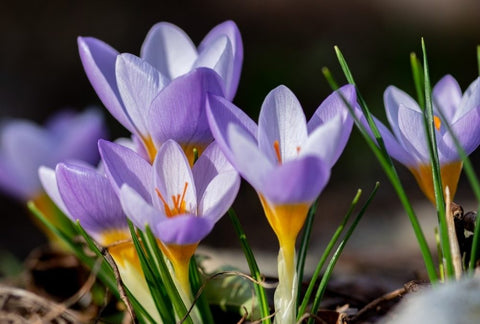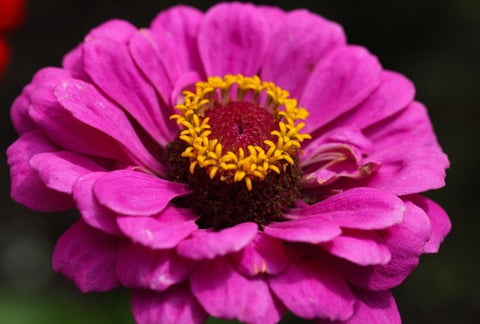Marigolds are known as the flower of the dead in pre-Hispanic Mexico and are still regarded as an important symbol used during Day of the Dead festivities!

Timing
Sprouts in 1-2 weeks. Harvest from Month 2+ on.

Part sun
Equivalent of 5+ hours of direct sun [DLI of 15+ mol/m²/day].

Care
Beginner friendly. You’ll sprout, thin, and deadhead.
Best Marigold Plant Varieties to Grow Indoors
Most marigold varieties can be grown indoors. However, watch out for African varieties as they can grow up to 2 ft. tall. Dwarf versions are more suitable for indoor growing. Below are our most recommended varieties for growing marigolds indoors:
French
Produces beautiful orange, red, and yellow flowers that are edible, too! Add them to salads, desserts, egg or rice dishes, or soups for added flavor.
Signet
Can be used for culinary purposes, just remove them once in full bloom. They also help keep mosquitoes away.
Triploid Hybrid
Crosses between African and French marigolds. Triploid hybrids are unable to set seed.
Dwarf African
Perfect for beds and borders. Superb for baskets, containers, and window boxes. Great for combination plantings.
Best Setup for Marigold Plants
You’ll need:
Planter:
Ceramic Self Watering Planter (preferred) or a pot that is at least 4″ / 1 pint.
Soil:
Standard Potting Mix
Plant Food:
At the start: Balanced Blend with equal parts nitrogen, phosphorus, and potassium (NPK 10-10-10).
Ongoing: Vegetable Blend high in phosphorus and low in nitrogen (NPK 4-10-6).
Grow Light:
A strong grow light that provides the equivalent of 5+ hours of direct sun [DLI of 15+ mol/m²/day].
Preparing Your Planter & Watering Schedule for Marigold
Marigold plants thrive in moist soil conditions. If the soil dries out completely, the roots will die back, making recovery difficult. Conversely, roots exposed to standing water can rot. A Ceramic Self Watering Planter filled with standard potting mix helps maintain consistent soil moisture.
To set one up:
- Fill up the planter with dry soil, gently tamping down the top.
- Dump the soil into a large mixing bowl and add water until the soil is moist but not sopping wet (about ½ cup).
- Mix in 1 tablespoon of Balanced Blend Plant Food.
If using a regular pot, it should be a bit larger (at least 4″ / 1 pint) with drainage holes to prevent overwatering. Let the top of the soil dry out between waterings.
Growing Your Marigolds Indoors: Seed vs Cutting vs Nursery Plant
Marigolds can be started from seed, propagated from an established plant, or purchased live from garden centers. Sprouting from seed or propagating from a stem cutting results in plants adapted to your growing conditions and reduces the risk of bringing home pests.
How to Plant Marigold Seeds
Marigold grows quickly from seed. Plant 1 site in a 4″ / 1-pint container. In larger containers, space sites 4″ apart. For each site, plant 3 seeds 1/4 inches deep. Keep the soil warm (65-90°F, ideally 70°F). Sprouts typically appear in 7 days but can range from 5 to 10 days depending on conditions.
Propagating Marigold: How to Clone from a Stem Cutting
If you have a Marigold plant you love (or a friend does!), you can easily “clone” it with sharp scissors and a clean glass of water. Cut a couple of 6” shoots of new growth, avoiding woody stems. Remove the lower leaves, leaving the bottom half as stem. Place in a glass of 3” of water, ensuring the cut leaf spots are submerged. Place the glass on a bright windowsill and change the water every few days. In a couple of weeks, roots should emerge and you can transplant them into your container.
- Cut 6” section of new growth.
- Remove leaves halfway and place them in water on a sunny windowsill.
- Wait 7 days for a few ½ inch roots to form and carefully transplant into their final container.
How to Transplant Marigold
Live starter plants give you a big jump start on your first harvest. Choose the bushiest plant available at the garden center (tall and lanky ones will be weak growers) and inspect for pests. Leaves should be dark green without holes, spots, or curled edges. “Quarantine” your plant for a week after bringing it home to ensure it’s pest-free. Then, transplant your seedling into its final home.
- Remove some soil from its final planter, leaving enough space for the seedling base to be just higher than the soil surface.
- Hold the stem base with one hand, turn the pot over, and gently pull the seedling. Squeezing the pot can help dislodge it.
- Place it in its final container and fill around it with soil, ensuring it’s tight but not compacted.
Where to Grow Your Marigold Plants
Marigold plants need lots of light to grow and develop good flavor. Natural sunlight is great, but a grow light is recommended for a consistent supply. For an introduction to grow lights, check out our post on grow lights for indoor gardeners. We’ve also got a buying guide for screw-in types, but a good middle-of-the-road option is the 24W Screw in Bulb by Sansi.
How Bright Should Your Grow Light Be?
Marigold plants need the equivalent of 5+ hours of direct sunlight [DLI of 15+ mol/m²/day]. The 24W Sansi bulb should be placed 6 inches away from the top of the plant, providing a PPFD of 500 μmol/m²/s.
How Many Hours per Day Do Your Marigold Plants Need Under a Grow Light?
Marigold plants are “short-day” plants, meaning they develop faster with over 12 hours of darkness. We recommend setting up a timer for 10 hours of light per day to encourage flowering.
Marigold Plants Grow Faster in Warmer Temps
Marigold plants are “warm-weather crops” and will speed up their metabolism in warmer temperatures.
Ideal temperatures are around 65°F but anything between 50 and 70°F works well. If things get too hot, they’ll wilt and become prone to disease.
Week 1-2: Check for Sprouts
You could see seedlings in as little as 5 days (though 7 days is more typical). If it’s been 10 days and you still don’t have any sprouts, it’s likely that your setup is too cold.
Week 3: Thin Your Seedlings

Thin your planter to only have 1 seedling per site – leaving the largest plant. If you are using the recommended planter (at least 4″ / 1 pint) this will mean you’ve got 1 plant after thinning. By getting rid of the smaller seedlings, you’re allowing the biggest and strongest one to flourish by reducing its competition for water, food, and space.
If your seedlings are under 1 inch, stretching out, or folding over, it’s likely that they don’t have quite enough light.
Month 2+: How to Harvest Marigold
Pick flowers right as they open to encourage more flowers to grow. If you let flowers go to seed on the plant it will start to end their life cycle, so you should “deadhead” (remove the old flowers) to prolong the flowering season. If you fall behind, you can cut the plant by one-third which produces a second flush of leaves and flowers.
Year 1: End of Life
You can prolong your marigold’s life by pruning it and removing flowers before they have a chance to go to seed, but eventually, it will die. At this time, it’s best to clear the plant and start over.
Shop This Blog
The right supplies can take the guesswork out of caring for your plants – and turn care from a daily to weekly routine. Through our grow tests, we’ve found these products to produce the best indoor marigold (and also have simple maintenance). Plants are adaptable and can grow in many different conditions, so they are by no means necessary if you already have other supplies.
Best Containers for Marigold: Ceramic Self Watering Planters
Plants thrive on consistent moisture but can suffer if they’re waterlogged. A semi-porous ceramic self-regulates ideal conditions. Our favorite is the COSWIP planter. Runner up is XS Self Watering Planter by Wet Pot.
Best Soil for Marigold: Standard Potting Mix
Marigold likes a rich and moist root zone – so you are best off with a standard potting mix – we like this Potting Mix by Rosy Soil.
Best Nutrients for Marigold: Balanced Blend followed by Vegetable Blend
Marigold likes to start with nutrients that are equal parts nitrogen, phosphorus, and potassium (NPK 10-10-10). For this Balanced Blend, we recommend: Dr. Earth All Purpose
Once they are growing, it’s better to use plant food that is high in phosphorus and low in nitrogen (NPK 4-10-6). For this Vegetable Blend, we recommend: Joyful Dirt Tomato & Herb
Best Light for Marigold: DIY or Soltech
There is a very small chance that you have the bright windows needed to grow these without a grow light. If you are looking for a higher-end option – we love the Aspect Light by Soltech. For a more affordable option, a DIY setup using a 24W Screw-in Bulb by Sansi with a Clamp Light and Timer works well too. Check out our complete guide on a DIY setup for less than $40 or our buying guide for screw-in bulbs.








There are no comments for this article. Be the first one to leave a message!